Gustave Moreau (1826–1898)Hélène à la porte Scée/ Helen at the Scaean Gate, c. 1880sOil on canvasheight: 72 cm (28.3 in); width: 100 cm (39.3 in)Musée Gustave Moreau
Gustave Moreau, see below
The origins of Helen's myth date back to the Mycenaean age. The first record of her name appears in the poems of Homer, but scholars assume that such myths invented or received by the Mycenaean Greeks made their way to Homer. Her mythological birthplace was Sparta of the Age of Heroes, which features prominently in the canon of Greek myth: in later ancient Greek memory, the Mycenaean Bronze Age became the age of the Greek heroes.

Two Athenians, Theseus and Pirithous, who were both sons of gods, decided that they should have divine wives; they thus pledged to help each other abduct two daughters of Zeus. Theseus chose Helen, and Pirithous vowed to marry Persephone, the wife of Hades. Theseus took Helen and left her with his mother Aethra, in Athens. Theseus and Pirithous then traveled to the underworld, the domain of Hades, to kidnap Persephone. Hades pretended to offer them hospitality and set a feast, but, as soon as the pair sat down, snakes coiled around their feet and held them there. Helen's abduction caused an invasion of Athens by Castor and Pollux, who captured Aethra in revenge, and returned their sister to Sparta.
Pelagio Palagi (May 25, 1775 – March 6, 1860). Architect, portrait painter, furniture designer, ornamentalist, and collector, Filippo Pelagio Palagi had a self-described "mania for antique things" that affected all aspects of his life. His interest in archaeology began when he moved to Rome in 1806 and soon became a fundamental inspiration in his work. Palagi was interested in Egyptian, Greek, Etruscan, and Roman antiquity, whose motifs he inventively and eclectically combined in his furniture and ornament designs. Although he protested that he was "not well-off, otherwise [he] would not merely praise [antiquities] but would dearly love to own them," he was a passionate collector and amassed one of the richest archaeological collections of the 1800s. Palagi owned a considerable collection of bronzes, marble sculptures, Etruscan vases, and gold, silver, and glass objects acquired during his years living in Rome, Milan, and Turin. More on Pelagio Palagi
Helen in her youth: she is presented as a young princess wrestling naked in the palaestra (the ancient Greek wrestling school); an image alluding to a part of girls' physical education in classical Sparta. Helen was a girl who practices arms and hunts with her brothers. "... or like Helen, on the sands of Eurotas, between Castor and Pollux, one to be victor in boxing, the other with horses: with naked breasts she carried weapons, they say, and did not blush with her divine brothers there".
When it was time for Helen to marry, many kings and princes from around the world came to seek her hand, bringing rich gifts with them, or sent emissaries to do so on their behalf. The final decision was in the hands of Tyndareus (husband of Leda, and Helen's step father). Menelaus her future husband, did not attend but sent his brother, Agamemnon, to represent him.
Tyndareus was afraid to select a husband for his daughter, or send any of the suitors away, for fear of offending them and giving grounds for a quarrel. Odysseus was one of the suitors, but had brought no gifts because he believed he had little chance to win the contest. He thus promised to solve the problem, if Tyndareus in turn would support him in his courting of Penelope, the daughter of Icarius.
The marriage of Helen and Menelaus marks the beginning of the end of the age of heroes. Concluding the catalog of Helen's suitors, Hesiod reports Zeus' plan to obliterate the race of men and the heroes in particular. The Trojan War, caused by Helen's elopement with Paris, is going to be his means to this end.
Hans von Aachen began painting in Germany as a pupil of the Flemish master E. Jerrigh. He then, like many northern artists of his time, spent a long period in Italy. He lived in Venice from 1574 to 1588 and toured Florence and Rome. He initially became a pupil of Kaspar Rems, but soon decided to develop his own mannerist technique, by studying Tintoretto and Michelangelo's followers. However, during all of his life he was influenced by the style of Bartholomeus Spranger and Hendrick Goltzius who dominated the art scene in Germany at the time.
He returned to Germany in 1588 where he became well known as a painter of portraits for noble houses. He also produced historical and religious scenes and earned a wide reputation. In Munich he came into contact with the Imperial Court of Prague. In 1592 he was appointed official painter of Rudolph II, Holy Roman Emperor. However, Von Aachen only moved to Prague years later where he was commissioned to paint mythological and allegorical subjects such as his Liberation of Hungary (1598, Budapest). Emperor Rudolph II conferred knighthood on him in 1605. He became good friends with Kryštof Popel the Younger of Lobkowicz, the Chief Steward of the Kingdom of Bohemia. Von Aachen continued working on commissions under the newly appointed ruler, Matthias I. He died in Prague. More on Hans von Aachen
It is recounted that Zeus held a banquet in celebration of the marriage of Peleus and Thetis (parents of Achilles).

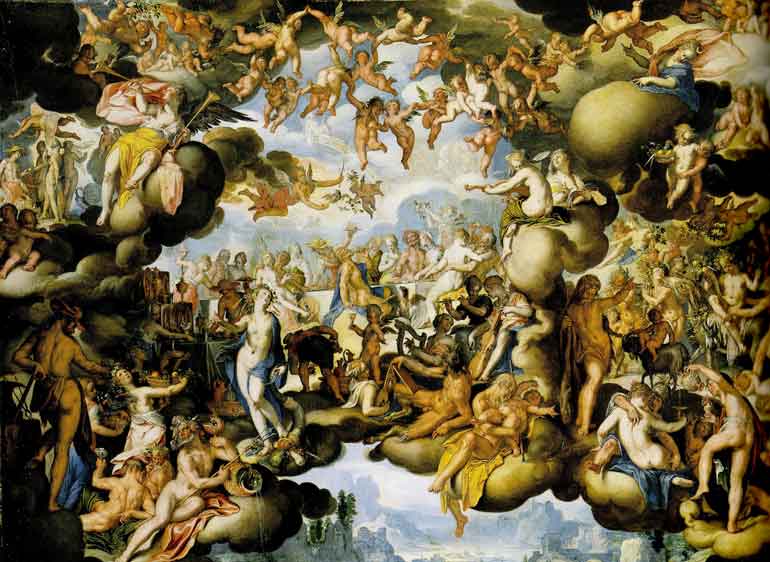

The Judgement of Paris produced by Peter Paul Rubens' version of idealised feminine beauty, with the goddesses Venus, Minerva and Juno on one side and Paris accompanied by Mercury on the other (the 1636 version has a putto at the far left and Alecto above the goddesses, whilst the 1638 version adds a putto between Minerva and Venus).
Sir Peter Paul Rubens (28 June 1577 – 30 May 1640) was a Flemish Baroque painter. A proponent of an extravagant Baroque style that emphasized movement, colour, and sensuality, Rubens is well known for his Counter-Reformation altarpieces, portraits, landscapes, and history paintings of mythological and allegorical subjects.
In addition to running a large studio in Antwerp that produced paintings popular with nobility and art collectors throughout Europe, Rubens was a classically educated humanist scholar and diplomat who was knighted by both Philip IV of Spain and Charles I of England. More on this painting

Sir Peter Paul Rubens (28 June 1577 – 30 May 1640) see above





Thus it happened that, with Hermes as their guide, the three candidates bathed in the spring of Ida, then confronted Paris on Mount Ida. While Paris inspected them, each attempted with her powers to bribe him; Hera offered to make him king of Europe and Asia, Athena offered wisdom and skill in war, and Aphrodite offered the world's most beautiful woman. This was Helen of Sparta, wife of the Greek king Menelaus. Paris accepted Aphrodite's gift and awarded the apple to her.
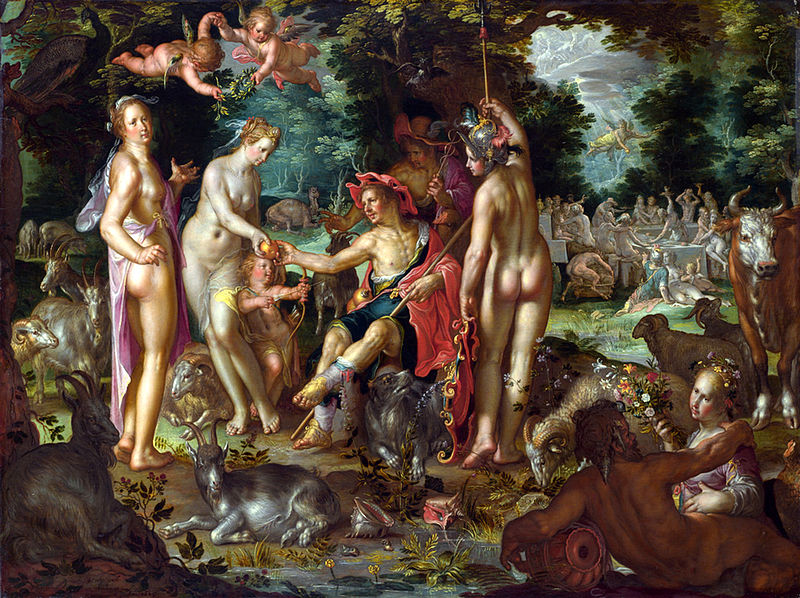
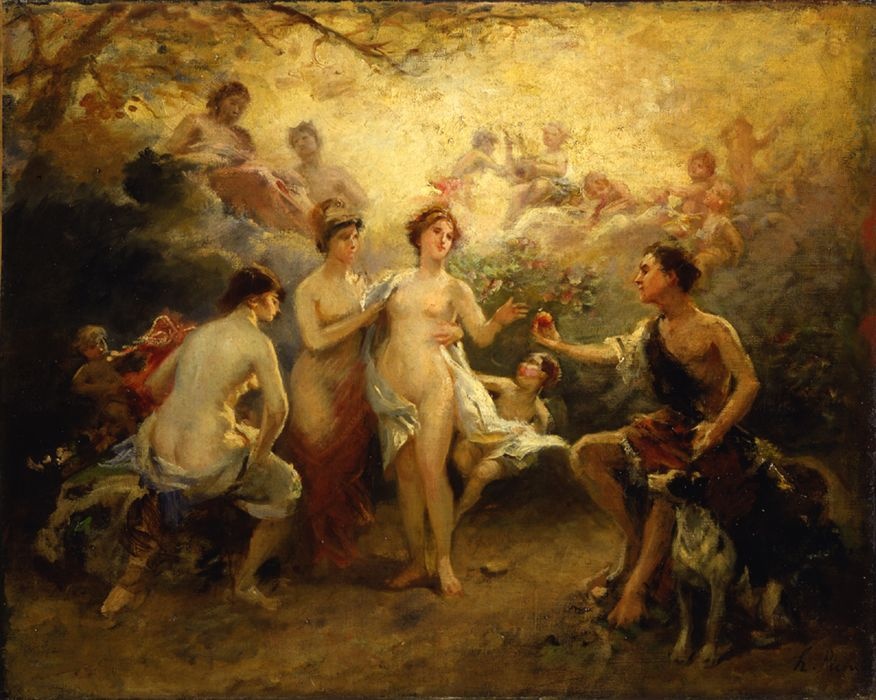




Alice's love of beautiful objects, historical artifacts and pattern combined with her interest in fairy tales and the more reflective nature of otherworldly deities has led her to cover a range of themes that touch on a number of genres and issues.
Alice completed her degree in Fine Art and English at Edge Hill University in 1998, obtaining a 1st class honours degree, continuing on to a Masters in 'Writing Studies', During this time she edited, published and wrote poetry and short fiction. More on Alice Lenkiewicz
Paris, came to Sparta to claim Helen.

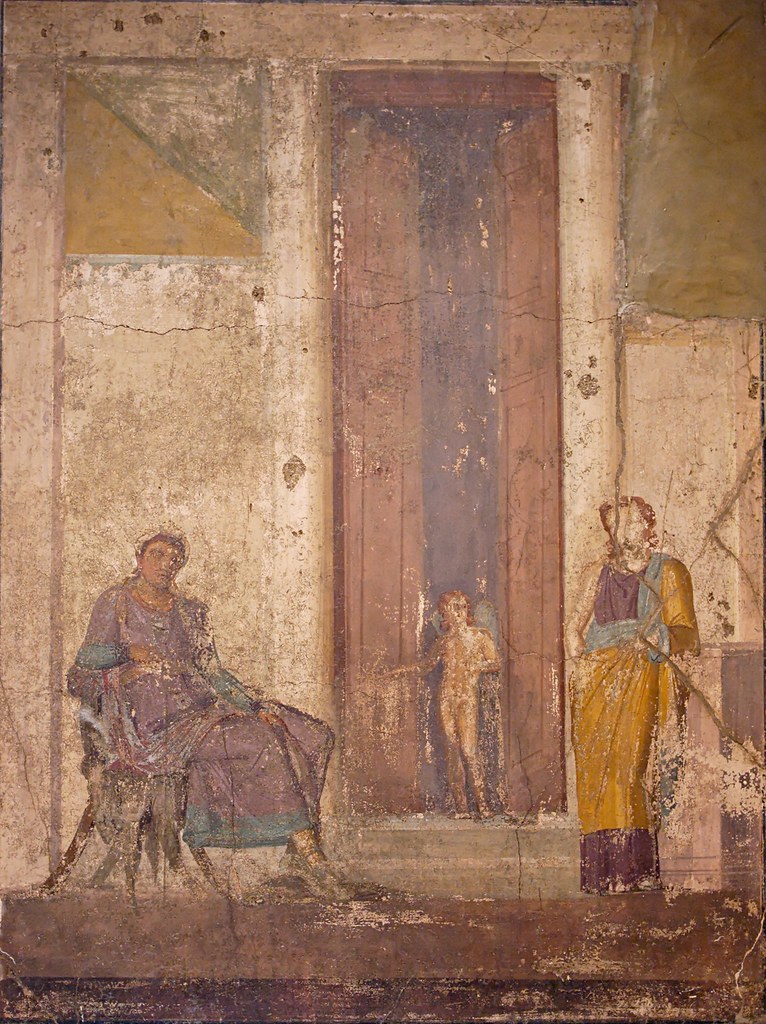

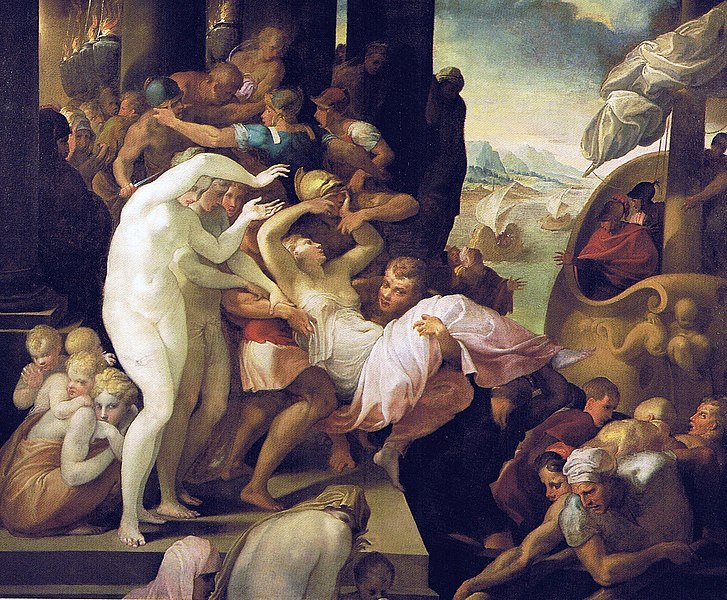



Pierre Claude François Delorme, born 28 July 1783, Paris, and died in the same city 8 November 1859 Is a French painter. After spending several years in Rome and Italy, where he studied Raphael and Michelangelo, he became a pupil of Anne-Louis Girodet and works according to the canons of the classical tradition of the Empire.
He first exhibited at the 1819 Paris Salon with a historical painting titled Death of Abel, now in the Musée Fabre in Montpellier. Delorme participated in the exhibitions of the Salon until 1851, mainly with mythological paintings, religious and historical. More on Pierre Claude François Delorme
Herodotus adds weight to the "Egyptian" version of events by putting forward his own evidence—he traveled to Egypt and interviewed the priests of the temple at Memphis. According to these priests, Helen had arrived in Egypt shortly after leaving Sparta, because strong winds had blown Paris's ship off course. King Proteus of Egypt, appalled that Paris had seduced his host's wife and plundered his host's home in Sparta, disallowed Paris from taking Helen to Troy. Paris returned to Troy without a new bride, but the Greeks refused to believe that Helen was in Egypt and not within Troy's walls. Thus, Helen waited in Memphis for ten years, while the Greeks and the Trojans fought. Following the conclusion of the Trojan War, Menelaus sailed to Memphis, where Proteus reunited him with Helen.
Gustave Moreau, (born April 6, 1826, Paris, France—died April 18, 1898, Paris), French Symbolist painter known for his erotic paintings of mythological and religious subjects.
The only influence that really affected Moreau’s development was that of his master, Théodore Chassériau (1819–56), an eclectic painter whose depictions of enigmatic sea goddesses deeply impressed his student. In the Salon of 1853 he exhibited Scene from the Song of Songs and the Death of Darius, both conspicuously under the influence of Chassériau.
Moreau’s Oedipus and the Sphinx (1864) and his The Apparition (Dance of Salome) (c. 1876) and Dance of Salome (c. 1876) show his work becoming increasingly concerned with exotic eroticism and violence, and his richly crowded canvases made greater use of dramatic lighting to heighten his brilliant, jewel-like colours. Moreau’s art has often been described as decadent. He made a number of technical experiments, including scraping his canvases; and his nonfigurative paintings, done in a loose manner with thick impasto, have led him to be called a herald of Abstract Expressionism.
Moreau succeeded Elie Delaunay as professor at the École des Beaux-Arts, and his teaching was highly popular. He was a very influential teacher of some of the artists of the Fauve movement, including Matisse and Rouault. At his death, Moreau left to the state his house and about 8,000 works, which now form the Musée Gustave Moreau in Paris. More on Gustave Moreau
When he discovered that his wife was missing, Menelaus called upon all the other suitors to fulfill their oaths, thus beginning the Trojan War. The Greek fleet gathered in Aulis, but the ships could not sail, because there was no wind.

He painted a Martyrdom of St. Maurelius for Ferrara Cathedral. He painted St Vincent in the act of curing a lunatic woman for the church of the Dominicans in Faenza. Other altarpieces were painted for churches in Rome, Turin, Milan, and other cities in Italy. More on Felice Torelli
Artemis was enraged by a sacrilegious act of the Greeks, and only the sacrifice of Agamemnon's daughter, Iphigenia, could appease her. In some versions, Iphigenia is sacrificed at Aulis, but in others, she is rescued by Artemis. In the version where she is saved, she goes to the Taurians and meets her brother Orestes.

He visited London twice, remaining on the second occasion—together with Rousseau and Monnoyer more than two years. William III vainly strove to detain him in England by the proposal that he should decorate Hampton Court, for Le Brun was dead, and Mansart pressed La Fosse to return to Paris to take in hand the cupola of Les Invalides. The decorations of Montagu House are destroyed, those of Versailles are restored, and the dome of the Invalides (engraved, Picart and Cochin) is now the only work existing which gives a full measure of his talent. During his latter years La Fosse executed many other important decorations in public buildings and private houses, notably in that of Crozat, under whose roof he died on 13 December 1716. The artis't works and conception played a key role in the French art history from shifting the classicism of the French style from the court of Louis XIV towards the lighter and more playful Rococo period's style. La Fosse's style prior to his emergence from the shadow of Le Brun remains a mystery, with very few sheets by him dating earlier than 1680. More on Charles de La Fosse
In Euripides’ Iphigenia at Aulis, it is Menelaus who convinces Agamemnon to heed the seer Calchas's advice. After Agamemnon sends a message to Clytemnestra informing her of Iphigenia's supposed marriage, he immediately regrets his decision and tries to send another letter telling them not to come. Menelaus intercepts the letter and he and Agamemnon argue. Menelaus insists that it is Agamemnon's duty to do all he can to aid the Greeks.
Jacques-Louis David (30 August 1748 – 29 December 1825) was an influential French painter in the Neoclassical style, considered to be the preeminent painter of the era. In the 1780s his cerebral brand of history painting marked a change in taste away from Rococo frivolity toward a classical austerity and severity, heightened feeling harmonizing with the moral climate of the final years of the Ancien Régime.
David later became an active supporter of the French Revolution and friend of Maximilien Robespierre (1758–1794), and was effectively a dictator of the arts under the French Republic. Imprisoned after Robespierre's fall from power, he aligned himself with yet another political regime upon his release: that of Napoleon, The First Consul of France. At this time he developed his Empire style, notable for its use of warm Venetian colours. After Napoleon's fall from Imperial power and the Bourbon revival, David exiled himself to Brussels, then in the United Kingdom of the Netherlands, where he remained until his death. David had a large number of pupils, making him the strongest influence in French art of the early 19th century, especially academic Salon painting. More on Jacques-Louis David
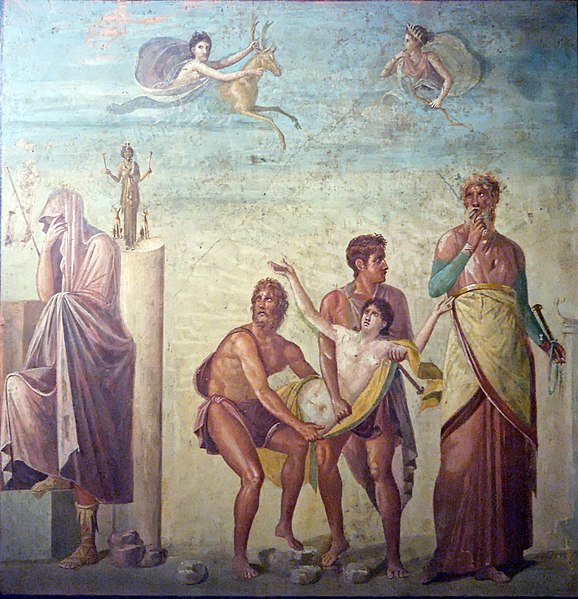
Fresco
Naples National Archaeological Museum Napoli, Italy

He died in Venice in 1769. He is represented in collections in e.g. Kadriorg Palace (part of the Art Museum of Estonia) in Tallinn, Estonia. More on Francesco Fontebasso
Before the opening of hostilities, the Greeks dispatched a delegation to the Trojans under Odysseus and Menelaus; they endeavored to persuade Priam (king of Troy) to hand Helen back without success.

In 1822 he became a Royal Academician, and almost from that time forward, and certainly for many years preceding his death, he seems to have abandoned painting, and ceased to contribute to the annual exhibitions of the Academy, his private fortune enabling him to live independently of his art. He died in London in 1857. More on Richard Cook
During the fall of Troy, Helen's role is ambiguous. Virgil's Aeneid gives an account of Helen's treacherous stance: when the Trojan Horse was admitted into the city, she feigned Bacchic rites, leading a chorus of Trojan women, and, holding a torch among them, she signaled to the Greeks from the city's central tower.
Domenico was born in Venice, studied under his father, and by the age of 13 was the chief assistant to him. He was one of the many assistants, including Lorenzo, who transferred the designs of his father (executed in the 'oil sketch' invented by the same). By the age of 20, he was producing his own work for commissioners.
He assisted his father in Würzburg 1751-3, decorating the famous stairwell fresco, in Vicenza at the Villa Valmarana in 1757, and in Madrid at the palace of Charles III from 1762-70. More on Giovanni Domenico Tiepolo
He won the prestigious Prix de Rome in 1861. Between 1855 and 1898, he exhibited 72 portraits in the Paris Salon. In 1891, he became a member of the French Académie des Beaux-Arts.
He was professor at the Académie Julian in Paris. Lefebvre is mainly remembred as an excellent and sympathetic teacher by his 1500 or more pupils. Among his famous students were Fernand Khnopff, Kenyon Cox, Félix Vallotton, Ernst Friedrich von Liphart, Georges Rochegrosse, the Scottish-born landscape painter William Hart, Walter Lofthouse Dean, and Edmund C. Tarbell, who became an American Impressionist painter.
Many of his paintings are single figures of beautiful women. Among his best portraits were those of M. L. Reynaud and the Prince Imperial (1874).[3]
Lefebvre died in Paris on 24 February 1912. More on Jules Joseph Lefebvre
In Odyssey, however, Homer narrates a different story: Helen circled the Horse three times, and she imitated the voices of the Greek women left behind at home—she thus tortured the men inside (including Odysseus and Menelaus) with the memory of their loved ones, and brought them to the brink of destruction
Helen returned to Sparta and lived for a time with Menelaus, where she was encountered by Telemachus in The Odyssey. According to another version, used by Euripides in his play Orestes, Helen had long ago left the mortal world by then, having been taken up to Olympus almost immediately after Menelaus' return.
From Antiquity, depicting Helen would be a remarkable challenge. The story of Zeuxis deals with this exact question: how would an artist immortalize ideal beauty? He eventually selected the best features from five virgins.
The Private Life of Helen of Troy, 1948

Cesare da Sesto, (1477–1523)
Odorico Politi, Italian, 1785-1846
Filippo Pelagio Palagi, 1775 - 1860
Francesco Primaticcio, (1505–1570)
Hans von Aachen, (1552–1615)
Joachim Wtewael, (1566 - 1638)
Peter Paul Rubens, (1577–1640)
Sandro Botticelli, (1445–1510)
Henri-Pierre Picou, (1824–1895)
Paul Cézanne, (1839–1906)
Anselm Feuerbach, (1829–1880)
Max Klinger, (1857–1920)
Enrique Simonet, (1866–1927)
Pierre-Auguste Renoir (1841–1919)
Gavin Hamilton, (1723–1798)
Angelica Kauffman, (1741–1807)
Luca Giordano, (Italian, 1634–1705)
Johann Georg Platzer, (1704–1761)
Francesco Primaticcio, (1505–1570)
Antonio Molinari, 1655 - 1704
Tintoretto, (1518–1594)
Piazzetta, Giovanni Battista, 1682 - 1754
Guido Reni (1575–1642)
Alessandro Turchi (Italian, 1578–1649)
Beaumont, Claudio Francesco, 1694-1766
Maarten van Heemskerck, (1498–1574)
Elbow Pierre François Delorme, (1783-1859)
Gerard de Lairesse, 1641 - 1711
Gustave Moreau, 1826 - 1898
Felice Torelli, (1667–1748)
Charles de La Fosse, (1636–1716)
Jacques-Louis David, (1748–1825)
François Perrier, (1594–1649)
Francesco Fontebasso, 1707 - 1769
Richard Cook, (1784–1857)
Giovanni Domenico Tiepolo, (1727–1804)
Jules Joseph Lefebvre, (1834–1912)
François-André Vincent, (1746–1816)
Please visit my other blogs: Art Collector, Mythology, Marine Art, Portrait of a Lady, The Orientalist, Art of the Nude and The Canals of Venice, Middle East Artists, 365 Saints, 365 Days, and Biblical Icons, also visit my Boards on Pinterest
Images are copyright of their respective owners, assignees or others.
Some Images may be subject to copyright
I don't own any of these images - credit is always given when due unless
it is unknown to me. if I post your images without your permission, please tell
me.
I do not sell art, art prints, framed posters or reproductions. Ads are
shown only to compensate the hosting expenses.
If you enjoyed this post, please share with friends and family.
Thank you for visiting my blog and also for liking its posts and pages.
Please note that the content of this post primarily consists of articles
available from Wikipedia or other free sources online.










,%20The%20Golden%20Apple%20of%20Discord.jpg)



























"Wow, this blog is simply amazing! The author's writing style is incredibly engaging and informative."
ReplyDeletewinco free turkey.
For some reason I was only advised of your comment today!!! Thanks you for your kind comments :)
DeleteGreat read thannks
ReplyDeleteThank you! Very glad you enjoyed :
DeleteI find it fascinating how different artists have interpreted Helen throughout history.
ReplyDelete